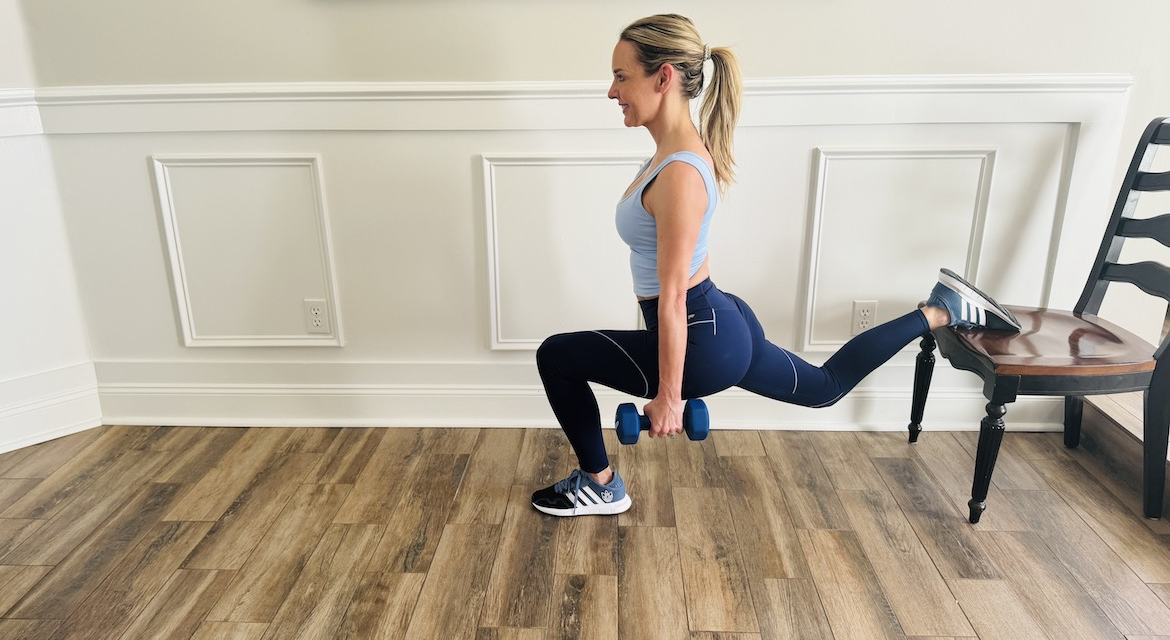A physical therapist swears by them.
The fastest way to improve your lower-body strength and balance is by adding single-leg exercises into your routine.
If you’ve been solely relying on double-leg exercises, such as traditional squats or calf raises, you may be favoring your dominant side without realizing it. Incorporating single-leg exercises can help you identify and address any muscle imbalances.
“It’s normal for one leg to be stronger than the other as nobody is perfectly symmetrical,” says Grayson Wickham, DPT, CSCS, physical therapist and founder of Movement Vault. “This is not an excuse to have a large strength difference in one leg versus the other. You should strive to have relatively equal strength in both legs and equal joint mobility in both of your hips, knees, and ankles.”
Ahead, we dive into the benefits of single-leg exercises and the best moves to add to your workout routine.
The benefits of single-leg exercises
Single-leg (unilateral) exercises are those exercises that require you to stand on one leg. Traditional double-leg exercises should have a place in your exercise routine, but there are some unique benefits of single-leg exercises.
“Everyone can benefit from adding single leg exercises to their workouts,” Dr. Wickham says. “With that said, if you notice you’re favoring one leg more than the other during a double-leg exercise, such as squats or deadlifts, you’ll want to incorporate single-leg exercises into your workouts.”
Here are seven major benefits of single-leg exercises.
1. They prevent muscle imbalances
“When only performing double-leg exercises, it’s common to create strength imbalances in one leg versus the other. Typically your dominant leg will get stronger over time as you tend to weight shift towards that leg during the exercise,” Dr. Wickham says. “Single-leg exercises are effective for improving strength differences and imbalances in one leg versus the other.”
Performing single-leg exercises forces your dominant leg to work just as hard as your non-dominant leg. You may not even realize how much your dominant side takes over until you try these exercises.
2. They ward off injuries
Single-leg exercises stave off injuries by preventing muscle imbalances that can lead to overtraining or repetitive injuries on the dominant side. Having equal muscle strength on both sides also ensures your body moves in a coordinated way, which can also prevent injuries.
This is of particular importance to athletes: A May 2011 study in Physical Therapy in Sport saw that soccer players with a 15 percent difference in leg muscle strength were 2.5 times more likely to have a leg injury. These findings can be translated to other leg-dominant sports, too.
3. They improve balance
“Single-leg exercises are great for improving your balance as you will be using one leg for support versus two legs,” says Wickham.
Standing on one leg forces your stabilizing muscles, including your core and glutes, to activate. The more you work on single-leg exercises, the stronger these stabilizing muscles become. This helps improve your balance and stability, which can help prevent injuries and falls, according to an April 2022 review in Perceptual and Motor Skills.
4. They strengthen your core
Single-leg exercises strengthen your core better than double-leg exercises, according to a small May 2012 study in the European Journal of Applied Physiology.
When standing on one leg, your core muscles must work hard to keep you stable and secure. Even though these exercises mostly strengthen your legs, they are also working your abdominals at the same time.
5. They’re great for post-injury rehab
Single-leg exercises are ideal for strengthening and regaining mobility in your leg after an injury. They’re important to ensure muscle imbalances don’t develop. They also help prevent and reverse muscle atrophy that may have occurred, especially if your lower extremity was immobilized in a cast for some time.
You may be surprised to learn that standing on one leg also helps to strengthen the opposite leg, in a phenomenon called cross-education of the muscles. For example, doing a single-leg calf raise on your right side helps strengthen your left calf. Researchers say it has to do with the neural pathways being connected to both sides of the body.
These types of exercises also help improve range of motion in your leg.
“Single-leg exercises can also be used to improve joint flexibility and mobility because you’ll l be able to perform exercises through a greater range of motion,” Dr. Wickham says.
6. They help improve sports performance
If you’re looking for a way to improve your performance with sports, you should give unilateral exercises a try. Many sports require you to be able to quickly shift your weight from one leg to the other with speed, balance, and agility. Some sports also require you to push off or jump on one leg.
Single-leg strengthening helped to improve the transfer of power from one leg to the other, how quickly you can change directions, and unilateral jump strength, according to a September 2022 study in Biology of Sports. These skills are useful for all sports.
7. They place less stress on your back
If you have back pain, single-leg exercises can help you strengthen your legs without putting as much stress on your back.
Single-leg exercises allow you to effectively strengthen your legs by holding lighter weights than you would need to with double-leg exercises, which puts less stress on your spine, a small August 2018 study in the International Journal of Sports Physical Therapy found.
“Everyone can benefit from adding single leg exercises to their workouts.” —Grayson Wickham, DPT, CSCS
The best single-leg exercises to add to your workouts
Try these seven single-leg exercises to improve strength, balance, and mobility.
“These exercises can be performed with added weight or bodyweight only,” Dr. Wickham says. “The key with these exercises when focusing on improving balance is to perform them slowly and through your full range of motion.”
If you have had any recent leg injuries, talk to your doctor before starting a new exercise routine. Stop if you have any pain with any exercise. If you’re unsure of your balance, make sure you have a stable surface close to hold onto as needed.
1. Bulgarian split squat
This single-leg exercise strengthens it all—your glutes, quads, hamstrings, and calves. Your core also works hard to keep you balanced and stable.
Start by performing this exercise without weight until you nail the form, and then add weight, gradually increasing the load as you get stronger. “Heavy single-leg Bulgarian split squats are my favorite single-leg exercise for strength,” Dr. Wickham says.
- Stand a few feet in front of a bench, box or chair, facing away from it.
- Reach your right foot back and place the top of your right foot flat on the surface. You may need to hop your left foot forward so you can do a proper lunge.
- Lean your torso forward slightly and bend your front knee to sink your hips toward the floor as low as you can comfortably go.
- Your front-leg shin should be vertical or close to it, while your back knee should point down toward the floor. If either leg is out of place, move your front foot forward or backward until you’ve found the ideal positioning.
- Push through the middle of your front foot to return to standing.
- Repeat for 3 sets of 12 to 15 reps on each leg. Complete all reps on one leg before switching to the other.
2. Single-leg Romanian deadlift
The single-leg Romanian deadlift targets your hamstring muscles, but also works your glutes, quads, calves, core, and back. This move is also a fabulous way to improve your balance and stability. You can start without weight until you get the form down.
- Stand shoulder-width apart. You may hold a dumbbell in each hand for added weight. Otherwise, place both hands on your hips.
- Shift your weight to your right leg.
- Engage your core and hinge your hips forward, extending your left leg behind you. Press your right foot into the ground while doing so, and keep your right leg slightly bent.
- Your back should be straight and you should be in a straight line from your head to your left foot. Keep your head looking forward.
- Slowly return to the starting position.
- Repeat for 2 to 3 sets of 10 to 12 reps. Complete all reps on one leg before switching to the other.
3. Hip airplane
This is one of Dr. Wickham’s favorite moves to work on both hip and glute strength and balance. Because there is also a rotational component to it, it also improves hip mobility.
- Start by standing with your feet shoulder-width apart.
- Shift your weight to your right leg and hinge forward at your waist with your arms straight out to the side.
- Keep your right leg slightly bent—don’t lock it out. Your left leg will be straight behind you.
- Continue hinging until your body is in a straight line. Your shoulders and hips should be pointed at the floor.
- Hold for 5 seconds.
- Next, rotate your shoulders and trunk as one unit in toward your standing leg.
- Hold for a few seconds and then return your torso so it’s back facing down toward the floor.
- Rotate your torso in the other direction, holding a few seconds before returning to the starting position with shoulders facing the floor.
- You can put your left leg down to rest between sets, or you can continue rotating to each side.
- Try to rotate 3 to 5 times on each side before standing up.
- Repeat for 1 to 3 sets.
4. Single-leg glute bridge
You’re probably familiar with the glute bridge exercise. The single-leg version really works your leg muscles, especially the gluteus maximus muscle (the largest butt muscle). It also strengthens your hamstrings, quads, and calves. In addition, your core muscles will be working hard to keep you stable throughout the motion.
The single-leg glute bridge is demonstrated below using a resistance band, but you can do it without the band and add it in once you’re ready for more resistance.
- Lie on your back with your knees bent and your feet flat on the floor, hip-width apart. Place your arms by your sides, palms on the floor.
- If using a resistance band, place it right above your knees.
- Lift your right foot off the ground and straighten it. Don’t raise it higher than your left knee.
- Pressing through your left heel, squeeze your core and glutes to lift your hips up off the ground.
- Hold for a few seconds and lower back down.
- Keeping your right leg in the air, continue lowering and raising your hips 12 to 15 times.
- Repeat with the other leg.
- Do 2 to 3 sets.
5. Single-leg squat
The single-leg squat is a more advanced move and should only be done if you’ve got basic squat form down. It strengthens your glutes, hamstrings, quads, calves, and core muscles. If you have any knee pain when doing this exercise, you should stick to the standard double-leg squat.
There are also several variations of this move: To make it easier, use a chair to squat into for more stability. To make it more difficult, you can do jump squats on one leg.
- Stand on your right foot.
- Hold your left leg straight out in front of you at about knee height.
- Push your hips back and and bend your right leg. Squat as far as you can comfortably go and still maintain control. Your goal should be until your hips are parallel to the ground.
- Return to a standing position.
- Repeat 10 to 12 times.
- Repeat on the other leg.
- Perform 2 to 3 sets.
6. Single-leg step-up
This single-leg exercise will work your core, but your glutes, calves, quads, and hamstrings will also feel the burn. This exercise strengthens your muscles concentrically (to lift you up on the step) and eccentrically (to lower you down on the step). You can hold dumbbells in each hand for added weight.
- Stand in front of a stair, step, or box.
- Place your left foot up on the step. The step should ideally be high enough so that your knee is at a 90-degree angle.
- Press into the heel of your left foot as you lift yourself up until your left leg is straight.
- Your right foot can come up on the step but try to keep your weight shifted to your left side.
- Slowly lower yourself down.
- Repeat 10 to 15 times.
- Repeat on the other leg.
- Perform 2 to 3 sets.
7. Single-leg calf raise
For those looking to build up their calf muscles, this single-leg version is very effective. In addition to strengthening, this exercise increases the flexibility of your calf. Hold dumbbells for added weight and to build up muscle mass more quickly.
- Stand on a stair, step, or box. Hold onto a wall or other stable surface for support if needed.
- Stand on your right leg and let your right heel hang off the step, keeping the front half of your foot on the step.
- Push through your right foot as you raise the heel of your right foot as high as it will go.
- Pause for a second and lower your right heel back down. You will feel a stretch along the back of your right calf.
- Repeat 12 to 15 times.
- Repeat on the other leg.
- Perform 2 to 3 sets.
Recommended Story For You :

The alpine secret for healthy weight loss

The Most Potent Fast-Acting Formula For Incinerating Stubborn Fat

Real Cortexi Users Real Life‑Changing Results

This Cold Drink Might Trigger Your Prostate

Red Boost is a powerful new formula for boosting male sexual health.

Everything you eat or drink eventually reaches your liver for processing.

Brand New Probiotics Specially Designed For The Health Of Your Teeth And Gums

Empowering You to Take Control of Your Blood Sugar Health!

Scientists Finally Discover the Root Cause of Belly Fat and Unexplained Weight Gain






